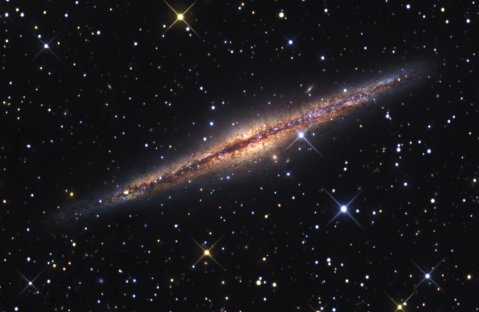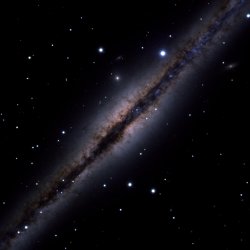Universe shines twice as bright

The Universe is actually twice as bright than was previously thought, according to research conducted by an international team of astronomers.
Dr Simon Driver from the University of St Andrews has discovered dust is obscuring approximately half of the light that the Universe is generating.
Lead author Dr Driver of the School of Physics and Astronomy said, “For nearly two decades we¿ve argued about whether the light that we see from distant galaxies tells the whole story or not. It doesn’t; in fact only half the energy produced by stars actually reaches our telescopes directly, the rest is blocked by dust grains.”
While astronomers have known for some time that the Universe contains small grains of dust, they had not realised the extent to which this is restricting the amount of light that we can see. The dust absorbs starlight and re-emits it, making it glow. They knew that existing models were flawed, because the energy output from glowing dust appeared to be greater than the total energy produced by the stars.
Dr Driver explained, “You can’t get more energy out than you put in so we knew something was very wrong. Even so, the scale of the dust problem has come as a shock – it appears galaxies are generating twice as much starlight as previously thought!”
The team combined an innovative new model of the dust distribution in galaxies developed by Dr Cristina Popescu of the University of Central Lancashire and Prof Richard Tuffs of the Max Plank Institute for Nuclear Physics, with data from the Millennium Galaxy Catalogue, a state-of-the-art high resolution catalogue of 10,000 galaxies assembled by Driver and his team.
Using the new model, the astronomers could calculate precisely the fraction of starlight blocked by the dust. The key test that the new model passed was whether the energy of the absorbed starlight equated to that detected from the glowing dust.
“The equation balanced perfectly”, said Dr Cristina Popescu, “and for the first time we have a total understanding of the energy output of the Universe over a monumental wavelength range. With the new calibrated model in hand we can now calculate precisely the fraction of starlight blocked by the dust.”

The Universe is currently generating energy, via nuclear fusion in the cores of stars, at a whopping rate of 5 quadrillion Watts per cubic light year – about 300 times the average energy consumption of the Earth’s population.
“For over 70 years an accurate description of how galaxies, the locations where matter is churned into energy, form and evolve has eluded us. Balancing the cosmic energy budget is an important step forward,” said Dr Driver.
After carefully measuring the brightness of thousands of disc-shaped galaxies with different orientations, the astronomers matched their observations to computer models of dusty galaxies. From this they were able to calibrate the models and, for the first time, determine how much light is obscured when a galaxy has a face-on orientation. This then allowed them to determine the absolute fraction of light that escapes in each direction from a galaxy.
Dr Driver explained the discovery that only half of the visible starlight gets out, while a mere 10 percent of the UV radiation escapes from galaxies. He said, “When the dust blocks the light, it is effectively heated and glows like the thermal images seen with military night vision goggles.
“When we look at galaxies using infrared satellites, we actually see the warm dust glowing. The amount of energy which the Universe is releasing at these wavelengths exactly balanced our determination of how much UV and visible light is absorbed by the dust.”
While modern instruments allow astronomers to see further into space, they can’t eliminate the obscuring effect from these tiny dust grains. The work is set to continue but with a change of focus from the study of the Universe as a whole, to the study of individual galaxies. This requires two new facilities which are coming online this year. The first is the VISTA telescope, which will soon commence operations in Chile and the second is the Herschel satellite due for launch later in the year.
Dr Driver continued, “We still aren’t able to observe the Universe in its full glory, however we do now better understand the effect that all of this dust is having on scientific observations.”
UK astronomers enjoy full access to both of these facilities through the UK’s membership, paid by the Science and Technology Facilities Council, of the European Southern Observatory and the European Space Agency which are responsible for operating these facilities.
The research is published in the latest Astrophysical Journal Letters (10th May).
Note to Editors:
Authors: Simon Driver (University of St Andrews, Scotland), Cristina Popescu (University of Central Lancashire, England), Richard Tuffs (Max-Planck Institute fur Nuclear Physics, Germany), Alister Graham (Swinburne University of Technology, Australia), Jochen Liske (European Southern Observatory, Germany), Ivan Baldry (Liverpool John Moores University, England).
This research has been funded by the Science and Technology Facilities Council (STFC), the Australian Research Council, the Max-Planck Society and a Livesey award from the University of Central Lancashire.
The Millennium Galaxy Catalogue consists of data from the Anglo-Australian Telescope, The Australian National University’s 2.3 m telescope at Siding Spring Observatory, the Isaac Newton Telescope and the Telescopio Nazionale Galileo at the Spanish Observatorio del Roque de Los Muchachos, La Palma, of the Instituto de Astrofisica de Canarias, and also from the Gemini and ESO New Technology Telescopes in Chile.
The researchers are available for interview:
Dr Simon Driver, University of St Andrew: 01334-461680/ 07919305906 or email [email protected]
Dr Cristina Popescu, University of Central Lancashire: 01772 893 551 or email [email protected]
Dr Ivan Baldry, Liverpool John Moores University: [email protected]
Dr Richard Tuffs,Max Plank Institute for Nuclear Physics: [email protected]
Dr Alister Graham, Swinburne University of Technology: [email protected] or Tel: +61 3 9214 8784
Dr Jochen Liske, ESO: [email protected] or Tel: +49 89 32006582
Note to Picture Editors:-
High resolution images showing galaxies known to contain dust obscuring the stars are available from http://astronomy.swin.edu.au/~agraham/dust/dust.html
Issued by the Press Office, University of St Andrews
Contact Fiona Armstrong, Press Officer on 01334 462530 / 467227, 07730 415 015 or email [email protected]
STFC Press Office Contact Julia Maddock on +44 1793 442094 / +44 7901 514 975 or email [email protected]
Ref: cosmic energy 150508
View the latest University press releases at www.st-andrews.ac.uk
Category Research